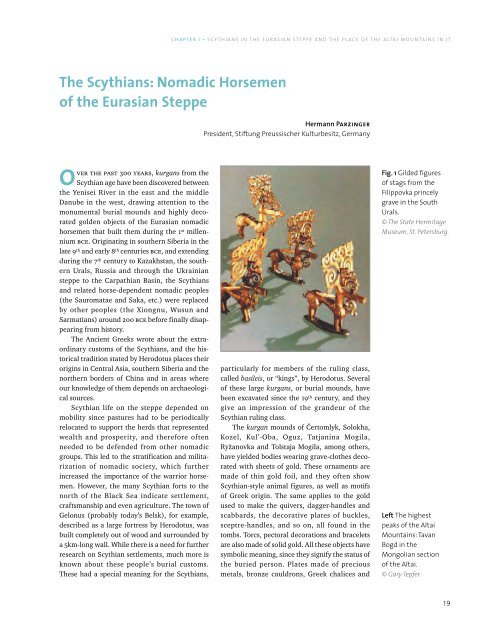Scythian Culture - Preservation of The Frozen Tombs of The Altai Mountains (UNESCO)
You also want an ePaper? Increase the reach of your titles
YUMPU automatically turns print PDFs into web optimized ePapers that Google loves.
CHAPTER I • SCYTHIANS IN THE EURASIAN STEPPE AND THE PLACE OF THE ALTAI MOUNTAINS IN IT<br />
<strong>The</strong> <strong>Scythian</strong>s: Nomadic Horsemen<br />
<strong>of</strong> the Eurasian Steppe<br />
Hermann Parzinger<br />
President, Stiftung Preussischer Kulturbesitz, Germany<br />
Over the past 300 years, kurgans from the<br />
<strong>Scythian</strong> age have been discovered between<br />
the Yenisei River in the east and the middle<br />
Danube in the west, drawing attention to the<br />
monumental burial mounds and highly decorated<br />
golden objects <strong>of</strong> the Eurasian nomadic<br />
horsemen that built them during the 1 st millennium<br />
bce. Originating in southern Siberia in the<br />
late 9 th and early 8 th centuries bce, and extending<br />
during the 7 th century to Kazakhstan, the southern<br />
Urals, Russia and through the Ukrainian<br />
steppe to the Carpathian Basin, the <strong>Scythian</strong>s<br />
and related horse-dependent nomadic peoples<br />
(the Sauromatae and Saka, etc.) were replaced<br />
by other peoples (the Xiongnu, Wusun and<br />
Sarmatians) around 200 bce before finally disappearing<br />
from history.<br />
<strong>The</strong> Ancient Greeks wrote about the extraordinary<br />
customs <strong>of</strong> the <strong>Scythian</strong>s, and the historical<br />
tradition stated by Herodotus places their<br />
origins in Central Asia, southern Siberia and the<br />
northern borders <strong>of</strong> China and in areas where<br />
our knowledge <strong>of</strong> them depends on archaeological<br />
sources.<br />
<strong>Scythian</strong> life on the steppe depended on<br />
mobility since pastures had to be periodically<br />
relocated to support the herds that represented<br />
wealth and prosperity, and therefore <strong>of</strong>ten<br />
needed to be defended from other nomadic<br />
groups. This led to the stratification and militarization<br />
<strong>of</strong> nomadic society, which further<br />
increased the importance <strong>of</strong> the warrior horsemen.<br />
However, the many <strong>Scythian</strong> forts to the<br />
north <strong>of</strong> the Black Sea indicate settlement,<br />
craftsmanship and even agriculture. <strong>The</strong> town <strong>of</strong><br />
Gelonus (probably today’s Belsk), for example,<br />
described as a large fortress by Herodotus, was<br />
built completely out <strong>of</strong> wood and surrounded by<br />
a 5km-long wall. While there is a need for further<br />
research on <strong>Scythian</strong> settlements, much more is<br />
known about these people’s burial customs.<br />
<strong>The</strong>se had a special meaning for the <strong>Scythian</strong>s,<br />
particularly for members <strong>of</strong> the ruling class,<br />
called basileis, or “kings”, by Herodotus. Several<br />
<strong>of</strong> these large kurgans, or burial mounds, have<br />
been excavated since the 19 th century, and they<br />
give an impression <strong>of</strong> the grandeur <strong>of</strong> the<br />
<strong>Scythian</strong> ruling class.<br />
v<br />
<strong>The</strong> kurgan mounds <strong>of</strong> Certomlyk, Solokha,<br />
Kozel, Kul’-Oba, Oguz, Tatjanina Mogila,<br />
v<br />
Ryzanovka and Tolstaja Mogila, among others,<br />
have yielded bodies wearing grave-clothes decorated<br />
with sheets <strong>of</strong> gold. <strong>The</strong>se ornaments are<br />
made <strong>of</strong> thin gold foil, and they <strong>of</strong>ten show<br />
<strong>Scythian</strong>-style animal figures, as well as motifs<br />
<strong>of</strong> Greek origin. <strong>The</strong> same applies to the gold<br />
used to make the quivers, dagger-handles and<br />
scabbards, the decorative plates <strong>of</strong> buckles,<br />
sceptre-handles, and so on, all found in the<br />
tombs. Torcs, pectoral decorations and bracelets<br />
are also made <strong>of</strong> solid gold. All these objects have<br />
symbolic meaning, since they signify the status <strong>of</strong><br />
the buried person. Plates made <strong>of</strong> precious<br />
metals, bronze cauldrons, Greek chalices and<br />
Fig. 1 Gilded figures<br />
<strong>of</strong> stags from the<br />
Filippovka princely<br />
grave in the South<br />
Urals.<br />
© <strong>The</strong> State Hermitage<br />
Museum, St. Petersburg.<br />
Left <strong>The</strong> highest<br />
peaks <strong>of</strong> the <strong>Altai</strong><br />
<strong>Mountains</strong>: Tavan<br />
Bogd in the<br />
Mongolian section<br />
<strong>of</strong> the <strong>Altai</strong>.<br />
© Gary Tepfer.<br />
19
















